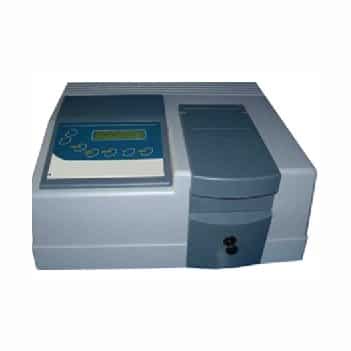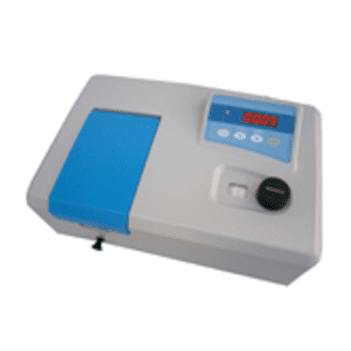A UV spectrophotometer is specifically designed to measure the absorbance of light in the ultraviolet (UV) range of the electromagnetic spectrum, typically between 190 to 380 nanometers (nm). It utilizes a UV light source and a detector to analyze the interactions of UV light with the sample. UV spectrophotometers are widely used in the analysis of organic compounds, including nucleic acids, proteins, and various pharmaceutical substances.
Key Features and Applications of UV Spectrophotometers:
A spectrophotometer is a more general instrument that measures the absorbance or transmittance of light over a broader range of the electromagnetic spectrum, typically from the UV to the visible and sometimes near-infrared regions. It consists of a light source, a monochromator to select specific wavelengths, a sample holder, and a detector. Spectrophotometers can be further classified based on the range of wavelengths they cover, such as UV-Vis spectrophotometers and visible spectrophotometers.
Key Features and Applications of Spectrophotometers:
In summary, UV spectrophotometers are specialized instruments tailored for analyzing samples in the UV range, while spectrophotometers have a broader wavelength range, including the UV and visible regions. The choice between UV and spectrophotometer depends on the specific application and the range of wavelengths needed for analysis.

| Model No | SI/UV-VS/D/2375 | |||
|---|---|---|---|---|
| Modes | Basic, Wavelength Scan, Multi-Wavelength,Kinetics, Quantitative, DNA/Protein | |||
| Wavelength Range | 190 – 1100 nm | |||
| Spectral Bandwidth | 1.0 nm | |||
| Optical System | Double Beam, Grating 1200 lines/mm | |||
| Wavelength Accuracy | ± 0.3 nm | |||
| Wavelength Repeatability | ± 0.2 nm | |||
| Scanning Speed | HI, MED, LOW, MAX. 3000 nm/min | |||
| Photometric Accuracy | ± 0.3 %T or ± 0.002 A/h @ 1A | |||
| Photometric Range | 0 – 200 %T, -0.3 to 3A, 0 – 9999 Conc. | |||
| Stray Light | < 0.05 %T @ 220, 340 nm | |||
| Stability | ± 0.001 A/h @ 500 nm | |||
| Display | 5 inches Graphic LCD (320 x 240 dots) | |||
| Baseline Flatness | ± 0.001A/h (200 – 1000 nm) | |||
| Sample Compartment | Standard 8 cell with automatic cell changer – 10 mm path-length, (50 & 100 mm path-length optional at extra cost) | |||
| Light Source | Halogen and Deuterium lamps (Pre-Aligned) | |||
| Output | USB Port for PC connectivity, Parallel Port for Dot Matrix Printer | |||
| Power | 230 V ± 10% AC, 50 Hz | |||
| Dimensions (L x B x H) | Instrument: 590 x 455 x 250 mm (Approx.) Box: 650 x 535 x 335 mm (Approx.) | |||
| Weight | Instrument: 17.5 Kg (Approx.) Box: 20 Kg (Approx.) | |||
| Accessories | Operation Manual and Dust Cover | |||
In UV spectrophotometry, the single beam configuration is a commonly used setup in which a sample and a reference are measured sequentially. Here is an introduction to the single beam UV spectrophotometer configuration:

| Model No | SI/UV-VS/S/2305 | |||
|---|---|---|---|---|
| Optics | Single Beam, Grating 1200 lines/mm | |||
| Wavelength Range | 325 - 1000 nm | |||
| Wavelength Resolution | 2 nm | |||
| Spectral Bandwidth | 4 nm | |||
| Wavelength Accuracy | ± 2 nm | |||
| Photometric Accuracy | ± 0.5 %T | |||
| Photometric Repeatability | 0.3 %T | |||
| Photometric Range | 0 - 200 %T, - 0.3 to 3A, 0 - 9999 Conc. | |||
| Photometric Mode | %Transmission, Absorbance, Concentration and K Factor | |||
| Stray Light | < 0.3 %T | |||
| Stability | ± 0.002 A/h @ 500 nm | |||
| Display | 4 Digit 7-Segment Bright Red LED | |||
| Detector | Silicon Photodiode | |||
| Sample Compartment | Standard 4-Position 10 mm path-length cuvette holder. Accommodates upto 100 mm path-length cuvette with optional holder | |||
| Output | USB port for PC Connectivity, Parallel Port for Dot Matirx Printer | |||
| Light Source | Tungsten Halogen Lamp | |||
| Power | 230 V ±10% AC, 50 Hz | |||
| Dimensions (L x B x H) | 420 x 280 x 180 mm (Approx.) | |||
| Weight | 8 Kg (Approx.) | |||
| Accessories | Operation Manual and Dust Cover |
A UV spectrophotometer is specifically designed to measure the absorbance of light in the ultraviolet (UV) range of the electromagnetic spectrum, typically between 190 to 380 nanometers (nm). It utilizes a UV light source and a detector to analyze the interactions of UV light with the sample. UV spectrophotometers are widely used in the analysis of organic compounds, including nucleic acids, proteins, and various pharmaceutical substances.
Key Features and Applications of UV Spectrophotometers:
A spectrophotometer is a more general instrument that measures the absorbance or transmittance of light over a broader range of the electromagnetic spectrum, typically from the UV to the visible and sometimes near-infrared regions. It consists of a light source, a monochromator to select specific wavelengths, a sample holder, and a detector. Spectrophotometers can be further classified based on the range of wavelengths they cover, such as UV-Vis spectrophotometers and visible spectrophotometers.
Key Features and Applications of Spectrophotometers:
In summary, UV spectrophotometers are specialized instruments tailored for analyzing samples in the UV range, while spectrophotometers have a broader wavelength range, including the UV and visible regions. The choice between UV and spectrophotometer depends on the specific application and the range of wavelengths needed for analysis.

| Model No | SI/UV-VS/D/1372 | |||
|---|---|---|---|---|
| Range | 190 - 1100 nm | |||
| Bandwidth | 2 nm | |||
| Accuracy | ± 0.5 nm | |||
| Readability | 0.1 nm | |||
| Repeatability | ± 0.2 nm | |||
| PHOTOMETRIC | ||||
| Range | %T: 0 - 100.0 %, Abs: 0 to ± 3.000 | |||
| Accuracy | ± 0.005 Abs @ 1.0 Abs, ± 0.010 Abs @ 1.5 Abs | |||
| Readability | %T: 0.1, Abs: 0.001 | |||
| Repeatability | ± 0.002 Abs @ 1.5 Abs | |||
| Stray Light | Less than 0.1 %T @ 260 nm with KI 10 g/l | |||
| System | Double Beam Optics | |||
| Light Sources | Deuterium Lamp (D2), Tungsten Halogen Lamp (W) | |||
| Monochromator | Czerny-Turner type with 1200 lines/mm | |||
| Detector | Wide range highly sensitive photodiode | |||
| OPERATIONAL | ||||
| Baseline Correction | Automatic baseline correction | |||
| Measuring Mode | Scan (%T & Abs.), Photometric (Multi-λ and Serial-λ), Concentration & Time Scan (Kinetics) | |||
| Scan Speed | Slow, Medium, & Fast | |||
| Scan Interval | 5 - 99 seconds | |||
| Sample Holder | Automatic 6-Position cuvette holder for 10 mm path-length cuvettes | |||
| Filters | Auto, in-built filter wheel | |||
| Data Storage | 1000 samples storage memory | |||
| DATA PRESENTATION | ||||
| Control | Microcontroller based | |||
| Display | 24 x 2 line alphanumeric backlit LCD display | |||
| Printer Interface | Available for any dot matrix centronics printer | |||
| Power | 230 V ± 10% AC, 50Hz, 150VA | |||
| Dimensions (L x B x H) | 615 x 495 x 155 mm (Approx.) | |||
| Weight | 28 Kg (Approx.) | |||
| Accessories | Operation Manual and Dust Cover | |||

Samara Instruments is a trusted source for cutting-edge scientific equipment. We specialize in providing high-quality instruments and solutions for researchers, laboratories, and scientific professionals worldwide. With 8 years of industry experience, we are committed to delivering innovative products that empower scientific discovery and advancement.

A UV spectrophotometer is specifically designed to measure the absorbance of light in the ultraviolet (UV) range of the electromagnetic spectrum, typically between 190 to 380 nanometers (nm). It utilizes a UV light source and a detector to analyze the interactions of UV light with the sample. UV spectrophotometers are widely used in the analysis of organic compounds, including nucleic acids, proteins, and various pharmaceutical substances.
A spectrophotometer is a more general instrument that measures the absorbance or transmittance of light over a broader range of the electromagnetic spectrum, typically from the UV to the visible and sometimes near-infrared regions. It consists of a light source, a monochromator to select specific wavelengths, a sample holder, and a detector. Spectrophotometers can be further classified based on the range of wavelengths they cover, such as UV-Vis spectrophotometers and visible spectrophotometers.
In summary, UV spectrophotometers are specialized instruments tailored for analyzing samples in the UV range, while spectrophotometers have a broader wavelength range, including the UV and visible regions. The choice between UV and spectrophotometer depends on the specific application and the range of wavelengths needed for analysis.
| Model No | SI/UV-VS/D/2375 | |||
|---|---|---|---|---|
| Modes | Basic, Wavelength Scan, Multi-Wavelength,Kinetics, Quantitative, DNA/Protein | |||
| Wavelength Range | 190 - 1100 nm | |||
| Spectral Bandwidth | 1.0 nm | |||
| Optical System | Double Beam, Grating 1200 lines/mm | |||
| Wavelength Accuracy | ± 0.3 nm | |||
| Wavelength Repeatability | ± 0.2 nm | |||
| Scanning Speed | HI, MED, LOW, MAX. 3000 nm/min | |||
| Photometric Accuracy | ± 0.3 %T or ± 0.002 A/h @ 1A | |||
| Photometric Range | 0 - 200 %T, -0.3 to 3A, 0 - 9999 Conc. | |||
| Stray Light | < 0.05 %T @ 220, 340 nm | |||
| Stability | ± 0.001 A/h @ 500 nm | |||
| Display | 5 inches Graphic LCD (320 x 240 dots) | |||
| Baseline Flatness | ± 0.001A/h (200 - 1000 nm) | |||
| Sample Compartment | Standard 8 cell with automatic cell changer – 10 mm path-length, (50 & 100 mm path-length optional at extra cost) | |||
| Light Source | Halogen and Deuterium lamps (Pre-Aligned) | |||
| Output | USB Port for PC connectivity, Parallel Port for Dot Matrix Printer | |||
| Power | 230 V ± 10% AC, 50 Hz | |||
| Dimensions (L x B x H) | Instrument: 590 x 455 x 250 mm (Approx.) Box: 650 x 535 x 335 mm (Approx.) | |||
| Weight | Instrument: 17.5 Kg (Approx.) Box: 20 Kg (Approx.) | |||
| Accessories | Operation Manual and Dust Cover | |||